Reflective Report on Business Decision Analytics (MGT602 Module)
VerifiedAdded on 2022/11/27
|9
|1424
|405
Report
AI Summary
This report, prepared for the MGT602 Business Decision Analytics course, provides a comprehensive analysis of decision-making styles and tools. The student reflects on personal decision-making preferences and contrasts them with major business decisions, highlighting the use of both rationality and intuition. The report examines various decision-making tools, including SWOT analysis and decision tree analysis, to address challenges like employee retention and operational efficiency. It also discusses the importance of data visualization and its qualities (truthful, functional, beautiful, insightful, and enlightening) for effective decision-making. The conclusion emphasizes the benefits of using effective decision-making tools to improve managerial processes and achieve competitive advantages, particularly in the context of a fast-changing workplace. The report includes references to relevant academic literature on business analytics and decision making.
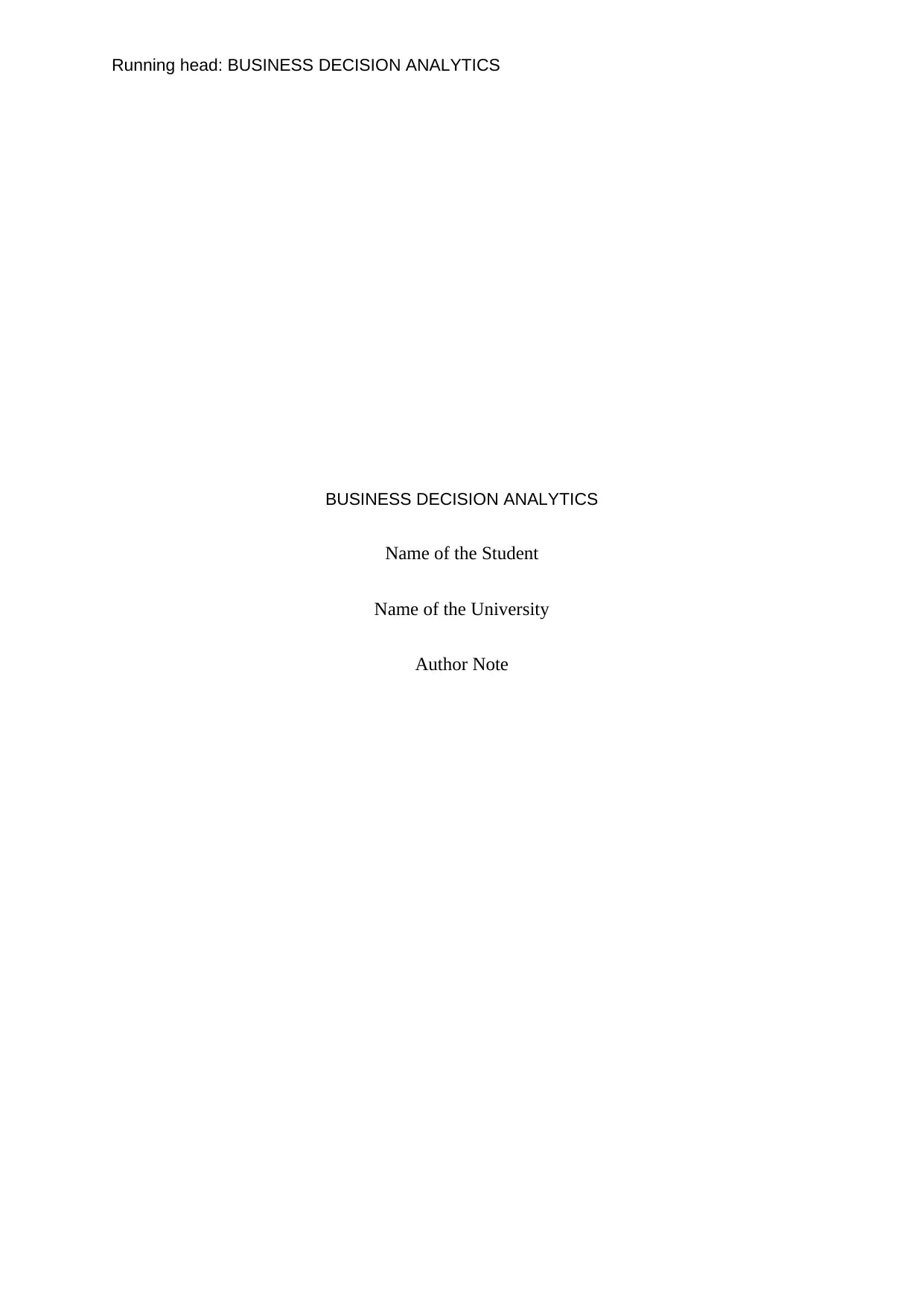
Running head: BUSINESS DECISION ANALYTICS
BUSINESS DECISION ANALYTICS
Name of the Student
Name of the University
Author Note
BUSINESS DECISION ANALYTICS
Name of the Student
Name of the University
Author Note
Paraphrase This Document
Need a fresh take? Get an instant paraphrase of this document with our AI Paraphraser
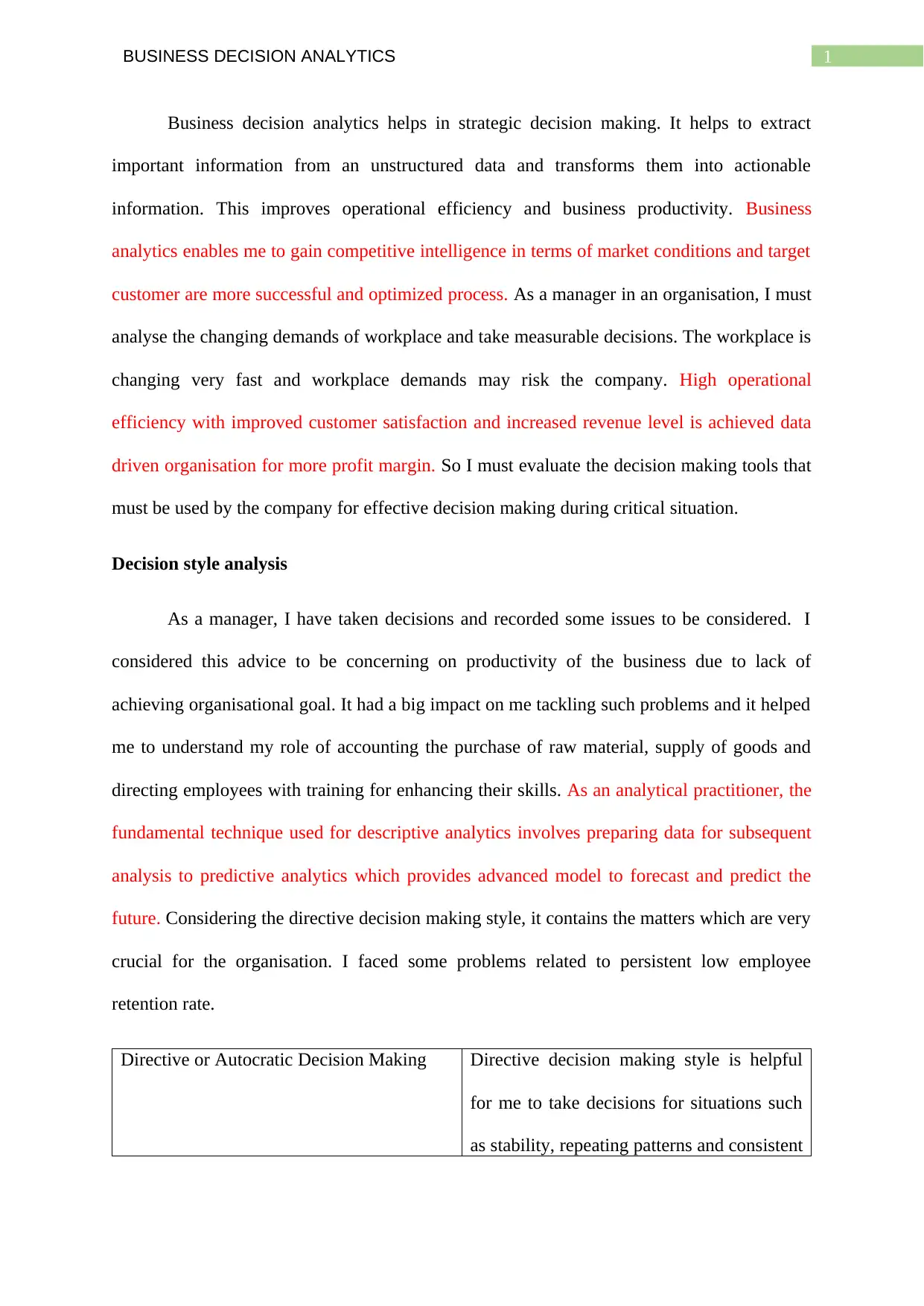
1BUSINESS DECISION ANALYTICS
Business decision analytics helps in strategic decision making. It helps to extract
important information from an unstructured data and transforms them into actionable
information. This improves operational efficiency and business productivity. Business
analytics enables me to gain competitive intelligence in terms of market conditions and target
customer are more successful and optimized process. As a manager in an organisation, I must
analyse the changing demands of workplace and take measurable decisions. The workplace is
changing very fast and workplace demands may risk the company. High operational
efficiency with improved customer satisfaction and increased revenue level is achieved data
driven organisation for more profit margin. So I must evaluate the decision making tools that
must be used by the company for effective decision making during critical situation.
Decision style analysis
As a manager, I have taken decisions and recorded some issues to be considered. I
considered this advice to be concerning on productivity of the business due to lack of
achieving organisational goal. It had a big impact on me tackling such problems and it helped
me to understand my role of accounting the purchase of raw material, supply of goods and
directing employees with training for enhancing their skills. As an analytical practitioner, the
fundamental technique used for descriptive analytics involves preparing data for subsequent
analysis to predictive analytics which provides advanced model to forecast and predict the
future. Considering the directive decision making style, it contains the matters which are very
crucial for the organisation. I faced some problems related to persistent low employee
retention rate.
Directive or Autocratic Decision Making Directive decision making style is helpful
for me to take decisions for situations such
as stability, repeating patterns and consistent
Business decision analytics helps in strategic decision making. It helps to extract
important information from an unstructured data and transforms them into actionable
information. This improves operational efficiency and business productivity. Business
analytics enables me to gain competitive intelligence in terms of market conditions and target
customer are more successful and optimized process. As a manager in an organisation, I must
analyse the changing demands of workplace and take measurable decisions. The workplace is
changing very fast and workplace demands may risk the company. High operational
efficiency with improved customer satisfaction and increased revenue level is achieved data
driven organisation for more profit margin. So I must evaluate the decision making tools that
must be used by the company for effective decision making during critical situation.
Decision style analysis
As a manager, I have taken decisions and recorded some issues to be considered. I
considered this advice to be concerning on productivity of the business due to lack of
achieving organisational goal. It had a big impact on me tackling such problems and it helped
me to understand my role of accounting the purchase of raw material, supply of goods and
directing employees with training for enhancing their skills. As an analytical practitioner, the
fundamental technique used for descriptive analytics involves preparing data for subsequent
analysis to predictive analytics which provides advanced model to forecast and predict the
future. Considering the directive decision making style, it contains the matters which are very
crucial for the organisation. I faced some problems related to persistent low employee
retention rate.
Directive or Autocratic Decision Making Directive decision making style is helpful
for me to take decisions for situations such
as stability, repeating patterns and consistent
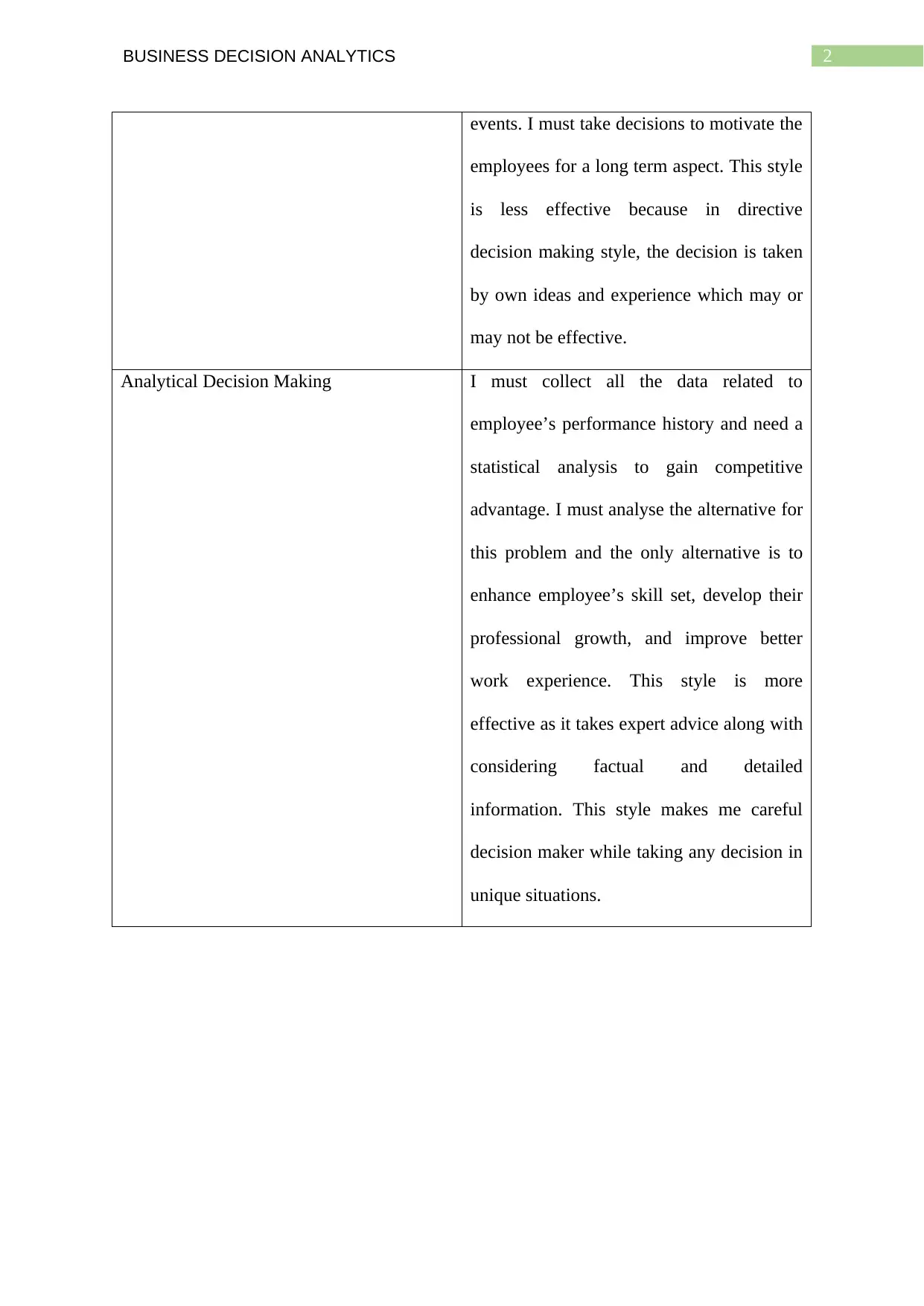
2BUSINESS DECISION ANALYTICS
events. I must take decisions to motivate the
employees for a long term aspect. This style
is less effective because in directive
decision making style, the decision is taken
by own ideas and experience which may or
may not be effective.
Analytical Decision Making I must collect all the data related to
employee’s performance history and need a
statistical analysis to gain competitive
advantage. I must analyse the alternative for
this problem and the only alternative is to
enhance employee’s skill set, develop their
professional growth, and improve better
work experience. This style is more
effective as it takes expert advice along with
considering factual and detailed
information. This style makes me careful
decision maker while taking any decision in
unique situations.
events. I must take decisions to motivate the
employees for a long term aspect. This style
is less effective because in directive
decision making style, the decision is taken
by own ideas and experience which may or
may not be effective.
Analytical Decision Making I must collect all the data related to
employee’s performance history and need a
statistical analysis to gain competitive
advantage. I must analyse the alternative for
this problem and the only alternative is to
enhance employee’s skill set, develop their
professional growth, and improve better
work experience. This style is more
effective as it takes expert advice along with
considering factual and detailed
information. This style makes me careful
decision maker while taking any decision in
unique situations.
⊘ This is a preview!⊘
Do you want full access?
Subscribe today to unlock all pages.

Trusted by 1+ million students worldwide
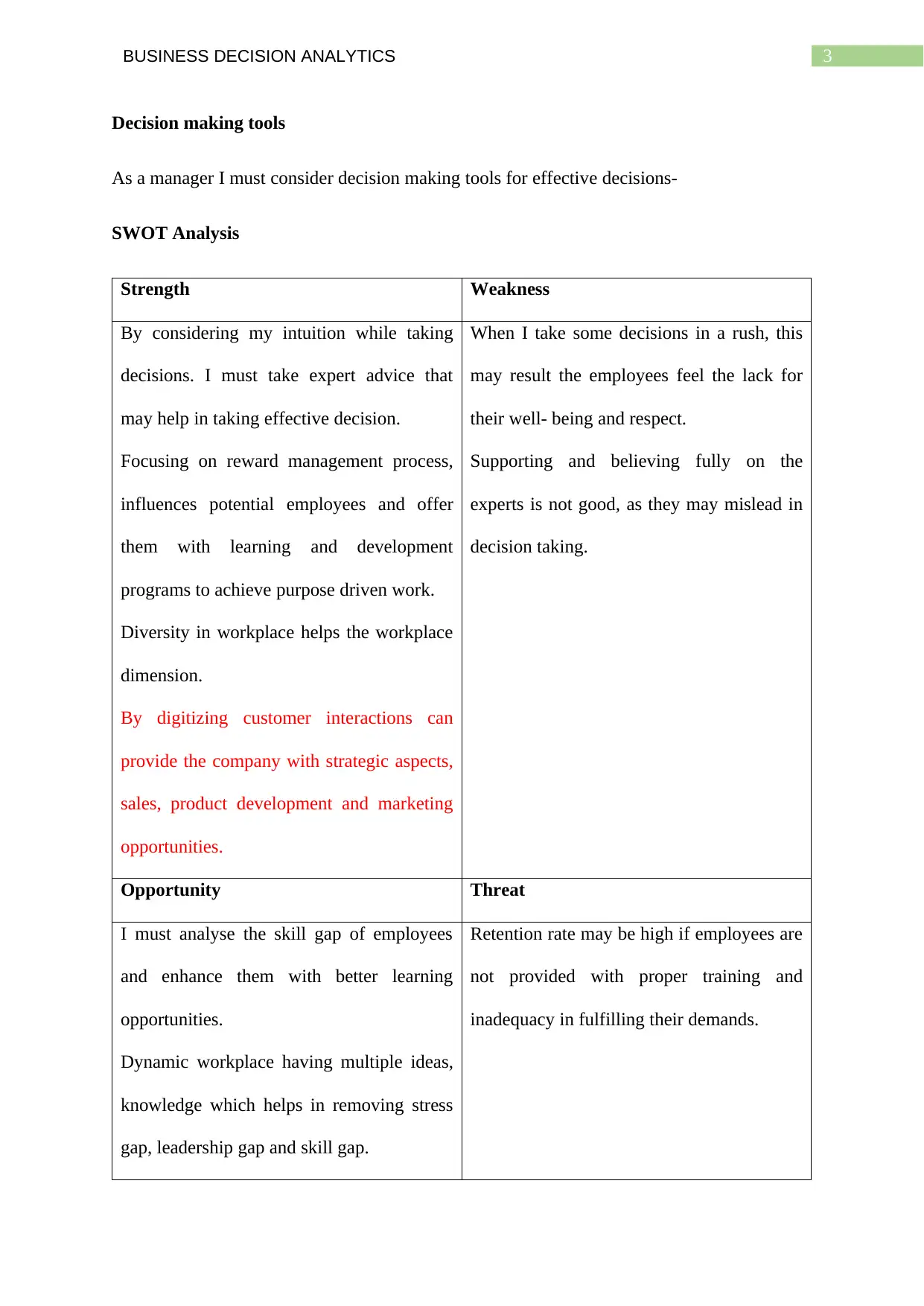
3BUSINESS DECISION ANALYTICS
Decision making tools
As a manager I must consider decision making tools for effective decisions-
SWOT Analysis
Strength Weakness
By considering my intuition while taking
decisions. I must take expert advice that
may help in taking effective decision.
Focusing on reward management process,
influences potential employees and offer
them with learning and development
programs to achieve purpose driven work.
Diversity in workplace helps the workplace
dimension.
By digitizing customer interactions can
provide the company with strategic aspects,
sales, product development and marketing
opportunities.
When I take some decisions in a rush, this
may result the employees feel the lack for
their well- being and respect.
Supporting and believing fully on the
experts is not good, as they may mislead in
decision taking.
Opportunity Threat
I must analyse the skill gap of employees
and enhance them with better learning
opportunities.
Dynamic workplace having multiple ideas,
knowledge which helps in removing stress
gap, leadership gap and skill gap.
Retention rate may be high if employees are
not provided with proper training and
inadequacy in fulfilling their demands.
Decision making tools
As a manager I must consider decision making tools for effective decisions-
SWOT Analysis
Strength Weakness
By considering my intuition while taking
decisions. I must take expert advice that
may help in taking effective decision.
Focusing on reward management process,
influences potential employees and offer
them with learning and development
programs to achieve purpose driven work.
Diversity in workplace helps the workplace
dimension.
By digitizing customer interactions can
provide the company with strategic aspects,
sales, product development and marketing
opportunities.
When I take some decisions in a rush, this
may result the employees feel the lack for
their well- being and respect.
Supporting and believing fully on the
experts is not good, as they may mislead in
decision taking.
Opportunity Threat
I must analyse the skill gap of employees
and enhance them with better learning
opportunities.
Dynamic workplace having multiple ideas,
knowledge which helps in removing stress
gap, leadership gap and skill gap.
Retention rate may be high if employees are
not provided with proper training and
inadequacy in fulfilling their demands.
Paraphrase This Document
Need a fresh take? Get an instant paraphrase of this document with our AI Paraphraser
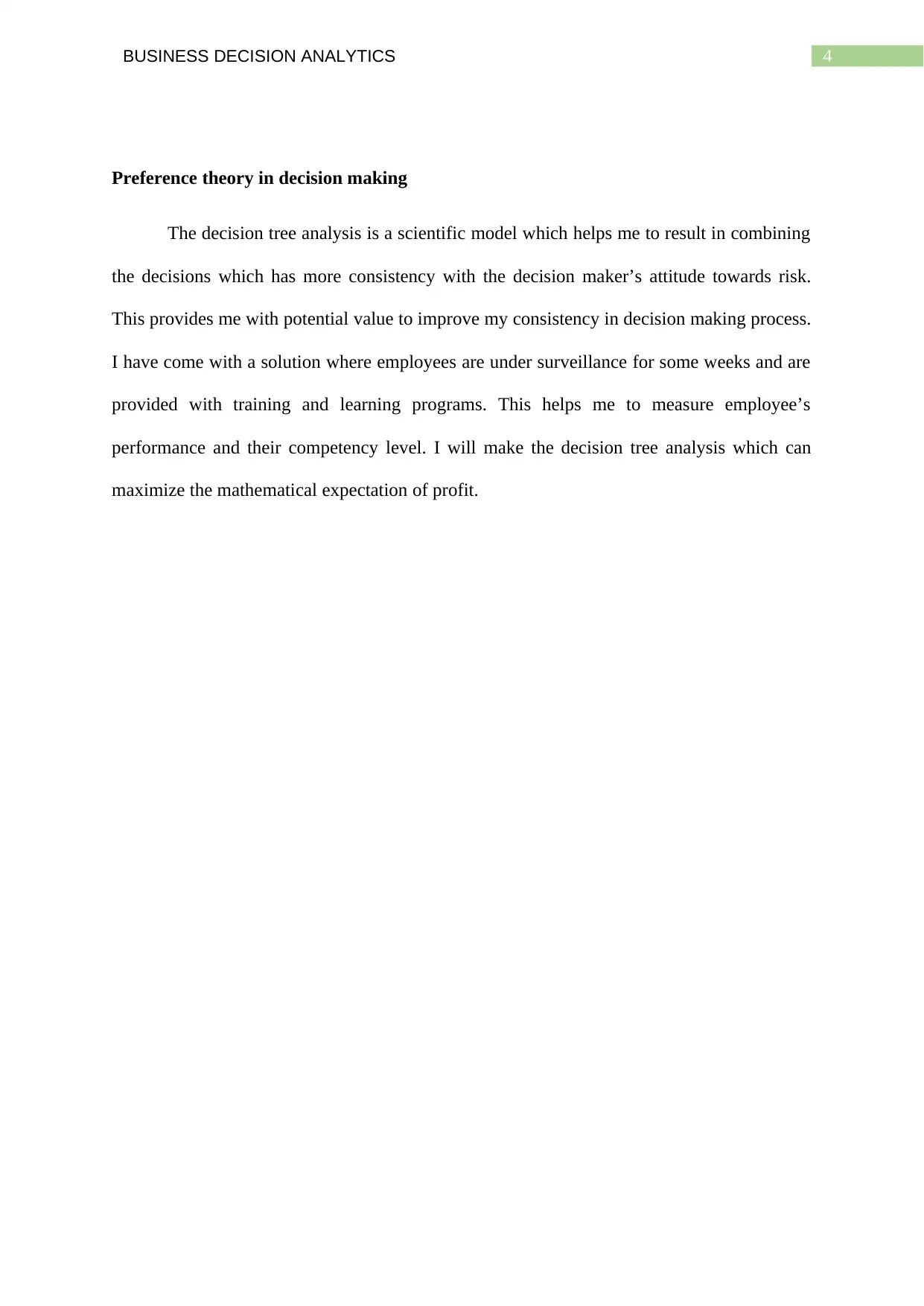
4BUSINESS DECISION ANALYTICS
Preference theory in decision making
The decision tree analysis is a scientific model which helps me to result in combining
the decisions which has more consistency with the decision maker’s attitude towards risk.
This provides me with potential value to improve my consistency in decision making process.
I have come with a solution where employees are under surveillance for some weeks and are
provided with training and learning programs. This helps me to measure employee’s
performance and their competency level. I will make the decision tree analysis which can
maximize the mathematical expectation of profit.
Preference theory in decision making
The decision tree analysis is a scientific model which helps me to result in combining
the decisions which has more consistency with the decision maker’s attitude towards risk.
This provides me with potential value to improve my consistency in decision making process.
I have come with a solution where employees are under surveillance for some weeks and are
provided with training and learning programs. This helps me to measure employee’s
performance and their competency level. I will make the decision tree analysis which can
maximize the mathematical expectation of profit.

5BUSINESS DECISION ANALYTICS
Figure: Decision tree
Employee training and
development program
Inefficient employees
after training program
Efficient employees
after training program
Improved
efficiency
Lack of
improvement
Ready for
appraisal
Good Performance
rating of employees
Figure: Decision tree
Employee training and
development program
Inefficient employees
after training program
Efficient employees
after training program
Improved
efficiency
Lack of
improvement
Ready for
appraisal
Good Performance
rating of employees
⊘ This is a preview!⊘
Do you want full access?
Subscribe today to unlock all pages.

Trusted by 1+ million students worldwide
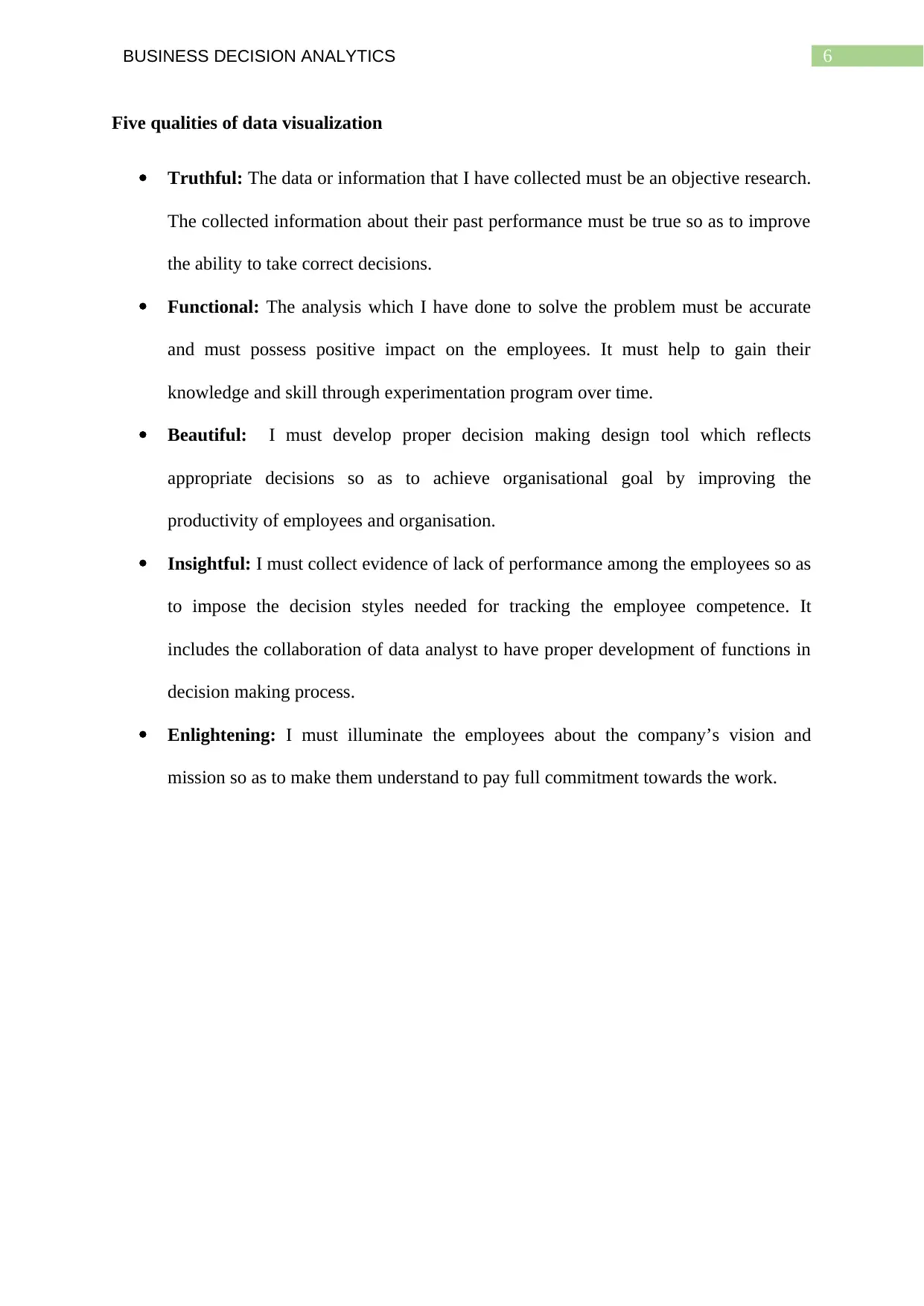
6BUSINESS DECISION ANALYTICS
Five qualities of data visualization
Truthful: The data or information that I have collected must be an objective research.
The collected information about their past performance must be true so as to improve
the ability to take correct decisions.
Functional: The analysis which I have done to solve the problem must be accurate
and must possess positive impact on the employees. It must help to gain their
knowledge and skill through experimentation program over time.
Beautiful: I must develop proper decision making design tool which reflects
appropriate decisions so as to achieve organisational goal by improving the
productivity of employees and organisation.
Insightful: I must collect evidence of lack of performance among the employees so as
to impose the decision styles needed for tracking the employee competence. It
includes the collaboration of data analyst to have proper development of functions in
decision making process.
Enlightening: I must illuminate the employees about the company’s vision and
mission so as to make them understand to pay full commitment towards the work.
Five qualities of data visualization
Truthful: The data or information that I have collected must be an objective research.
The collected information about their past performance must be true so as to improve
the ability to take correct decisions.
Functional: The analysis which I have done to solve the problem must be accurate
and must possess positive impact on the employees. It must help to gain their
knowledge and skill through experimentation program over time.
Beautiful: I must develop proper decision making design tool which reflects
appropriate decisions so as to achieve organisational goal by improving the
productivity of employees and organisation.
Insightful: I must collect evidence of lack of performance among the employees so as
to impose the decision styles needed for tracking the employee competence. It
includes the collaboration of data analyst to have proper development of functions in
decision making process.
Enlightening: I must illuminate the employees about the company’s vision and
mission so as to make them understand to pay full commitment towards the work.
Paraphrase This Document
Need a fresh take? Get an instant paraphrase of this document with our AI Paraphraser
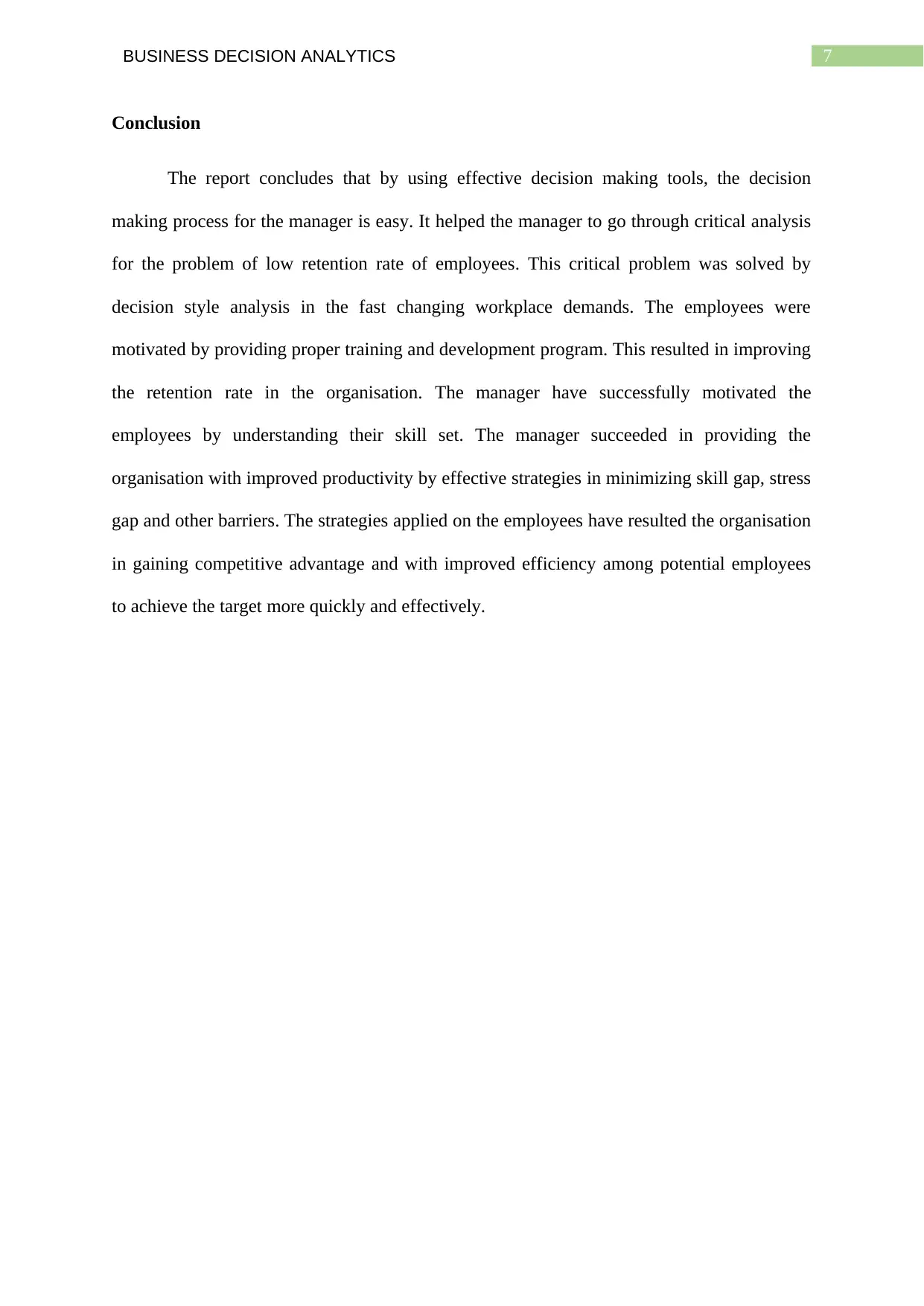
7BUSINESS DECISION ANALYTICS
Conclusion
The report concludes that by using effective decision making tools, the decision
making process for the manager is easy. It helped the manager to go through critical analysis
for the problem of low retention rate of employees. This critical problem was solved by
decision style analysis in the fast changing workplace demands. The employees were
motivated by providing proper training and development program. This resulted in improving
the retention rate in the organisation. The manager have successfully motivated the
employees by understanding their skill set. The manager succeeded in providing the
organisation with improved productivity by effective strategies in minimizing skill gap, stress
gap and other barriers. The strategies applied on the employees have resulted the organisation
in gaining competitive advantage and with improved efficiency among potential employees
to achieve the target more quickly and effectively.
Conclusion
The report concludes that by using effective decision making tools, the decision
making process for the manager is easy. It helped the manager to go through critical analysis
for the problem of low retention rate of employees. This critical problem was solved by
decision style analysis in the fast changing workplace demands. The employees were
motivated by providing proper training and development program. This resulted in improving
the retention rate in the organisation. The manager have successfully motivated the
employees by understanding their skill set. The manager succeeded in providing the
organisation with improved productivity by effective strategies in minimizing skill gap, stress
gap and other barriers. The strategies applied on the employees have resulted the organisation
in gaining competitive advantage and with improved efficiency among potential employees
to achieve the target more quickly and effectively.
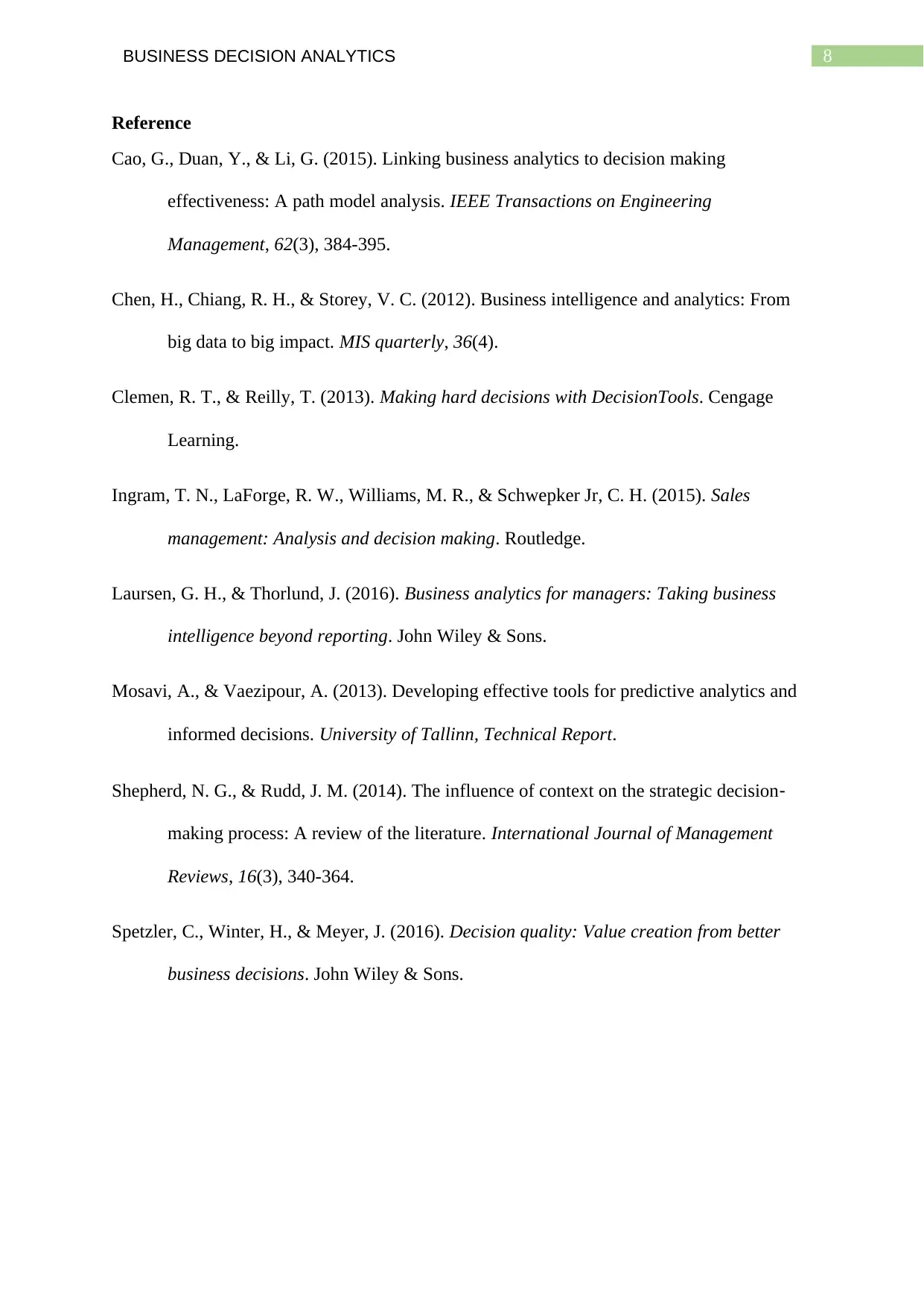
8BUSINESS DECISION ANALYTICS
Reference
Cao, G., Duan, Y., & Li, G. (2015). Linking business analytics to decision making
effectiveness: A path model analysis. IEEE Transactions on Engineering
Management, 62(3), 384-395.
Chen, H., Chiang, R. H., & Storey, V. C. (2012). Business intelligence and analytics: From
big data to big impact. MIS quarterly, 36(4).
Clemen, R. T., & Reilly, T. (2013). Making hard decisions with DecisionTools. Cengage
Learning.
Ingram, T. N., LaForge, R. W., Williams, M. R., & Schwepker Jr, C. H. (2015). Sales
management: Analysis and decision making. Routledge.
Laursen, G. H., & Thorlund, J. (2016). Business analytics for managers: Taking business
intelligence beyond reporting. John Wiley & Sons.
Mosavi, A., & Vaezipour, A. (2013). Developing effective tools for predictive analytics and
informed decisions. University of Tallinn, Technical Report.
Shepherd, N. G., & Rudd, J. M. (2014). The influence of context on the strategic decision‐
making process: A review of the literature. International Journal of Management
Reviews, 16(3), 340-364.
Spetzler, C., Winter, H., & Meyer, J. (2016). Decision quality: Value creation from better
business decisions. John Wiley & Sons.
Reference
Cao, G., Duan, Y., & Li, G. (2015). Linking business analytics to decision making
effectiveness: A path model analysis. IEEE Transactions on Engineering
Management, 62(3), 384-395.
Chen, H., Chiang, R. H., & Storey, V. C. (2012). Business intelligence and analytics: From
big data to big impact. MIS quarterly, 36(4).
Clemen, R. T., & Reilly, T. (2013). Making hard decisions with DecisionTools. Cengage
Learning.
Ingram, T. N., LaForge, R. W., Williams, M. R., & Schwepker Jr, C. H. (2015). Sales
management: Analysis and decision making. Routledge.
Laursen, G. H., & Thorlund, J. (2016). Business analytics for managers: Taking business
intelligence beyond reporting. John Wiley & Sons.
Mosavi, A., & Vaezipour, A. (2013). Developing effective tools for predictive analytics and
informed decisions. University of Tallinn, Technical Report.
Shepherd, N. G., & Rudd, J. M. (2014). The influence of context on the strategic decision‐
making process: A review of the literature. International Journal of Management
Reviews, 16(3), 340-364.
Spetzler, C., Winter, H., & Meyer, J. (2016). Decision quality: Value creation from better
business decisions. John Wiley & Sons.
⊘ This is a preview!⊘
Do you want full access?
Subscribe today to unlock all pages.

Trusted by 1+ million students worldwide
1 out of 9
Related Documents
Your All-in-One AI-Powered Toolkit for Academic Success.
+13062052269
info@desklib.com
Available 24*7 on WhatsApp / Email
![[object Object]](/_next/static/media/star-bottom.7253800d.svg)
Unlock your academic potential
Copyright © 2020–2025 A2Z Services. All Rights Reserved. Developed and managed by ZUCOL.





